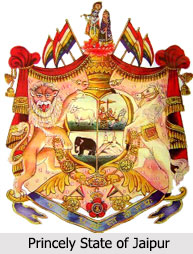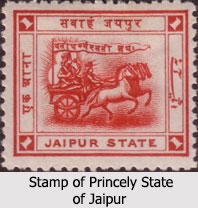 Princely State of Jaipur was under the indirect rule of the British Empire in India. The state was centred in the town of Jaipur which was also the capital of a princely state, which existed from the 12th century until the year 1947, when India attained independence. The name of the state was derived from the name of the Jaipur town. The state was scattered over a total area of 40,349 sq km in 1900.
Princely State of Jaipur was under the indirect rule of the British Empire in India. The state was centred in the town of Jaipur which was also the capital of a princely state, which existed from the 12th century until the year 1947, when India attained independence. The name of the state was derived from the name of the Jaipur town. The state was scattered over a total area of 40,349 sq km in 1900.
History of Princely State of Jaipur
Jaipur was the Princely State of India from 1128 to 1947 CE. It was ruled from the 12th century till India"s independence by different rulers in different ages like Dhundhar, Amber and Jaipur Kingdoms. Jaipur state was also ruled by Mughal Empire and later by British Empire. The city of Jaipur was founded by Maharaja Jai Singh II in the year 1728.
 Dhundhar Kingdom: The Kacchwahas of Dhundhar claim to be descendants of Raja Dhola of Narwar. The state of Jaipur was founded by Dulaha Raya around 1128, who came from Gwalior. He along with the other people from Kacchwaha seized the region and drove out the local Meenas and Rajput chiefs. In the Dhundhar region their initial capital was at Dausa, which was later shifted to Ramgarh and Amber and was finally relocated to Jaipur.
Dhundhar Kingdom: The Kacchwahas of Dhundhar claim to be descendants of Raja Dhola of Narwar. The state of Jaipur was founded by Dulaha Raya around 1128, who came from Gwalior. He along with the other people from Kacchwaha seized the region and drove out the local Meenas and Rajput chiefs. In the Dhundhar region their initial capital was at Dausa, which was later shifted to Ramgarh and Amber and was finally relocated to Jaipur.
Amber Kingdom: The rulers of Amber fought as generals in the army of Prithviraj Chauhan and later under the banner of Rana Sanga against the Mughals under Babur. Raja Bharmal"s daughter, Harkha Bai was married to Akbar. She became the mother of the fourth Mughal emperor Jahangir and gained prestige in Mughal court.
Jaipur Kingdom: Jai Singh I was succeeded by Ram Singh I, Bishan Singh and Jai Singh II. Jai Singh II, also known as Sawai Jai Singh, ruled the state from 1699 to 1743.
 During the collapse of the Mughal Empire, the forces of Jaipur were in a continuous state of conflict and combat. Towards the latter half of the 18th century, the chief of Alwar and the Jats of Bharatpur declared to be independent and autonomous from Jaipur. Each state annexed the eastern portion of the territory of Jaipur. This era of the history of Jaipur is categorized by internal conflicts and constant military clashes with the Jats, Marathas, other Rajput states, the Pindaris and the British Government of India. Later in 1803, a treaty was initially signed by Maharaja Sawai Jagat Singh and the British administration under Governor General Marquis Wellesley, but eventually the treaty was dissolved by Lord Cornwallis, the successor of Marquis Wellesley. In the year 1818, the Princely State of Jaipur entered into subsidiary alliance with the British East India Company.
During the collapse of the Mughal Empire, the forces of Jaipur were in a continuous state of conflict and combat. Towards the latter half of the 18th century, the chief of Alwar and the Jats of Bharatpur declared to be independent and autonomous from Jaipur. Each state annexed the eastern portion of the territory of Jaipur. This era of the history of Jaipur is categorized by internal conflicts and constant military clashes with the Jats, Marathas, other Rajput states, the Pindaris and the British Government of India. Later in 1803, a treaty was initially signed by Maharaja Sawai Jagat Singh and the British administration under Governor General Marquis Wellesley, but eventually the treaty was dissolved by Lord Cornwallis, the successor of Marquis Wellesley. In the year 1818, the Princely State of Jaipur entered into subsidiary alliance with the British East India Company.
After the British invoked the treaty to request support in the repression and restraint of mutinous sepoys, during the Sepoy Mutiny of 1857, the Maharaja decided to preserve the treaty and sent in military forces to pacify the uprisings in the region around Gurgaon. The troops of the Jaipur state also secured and kept open the strategic Agra-Ajmer highway. Moreover, they provided shelter to the British Officers who were escaping from the threat of the rebels in the Nahargarh Fort.
Maharajas of Princely State of Jaipur
The rulers or Maharajas of Jaipur belonged to the Kacchwaha clan of Rajputs, who claimed to be descents from Lord Rama, King of Ayodhya. After the nation attained independence in the year 1947, the then ruler of the state, Maharaja Sawai Man Singh II, acceded the princely state of Jaipur to the Union of India in 1948. Jaipur was incorporated into the Dominion of India and became the capital of Rajasthan. At present, Padmanabh Singh; grandson of Maharaja Sawai Bhawani Singh Bahadur is the current titular Maharaja of Jaipur.
The ruling dynasty of Jaipur state provided with some of their most distinguished generals to the Mughal Empire. Some of the most renowned generals were Man Singh I, who governed and fought from Kabul to Odisha and Assam; Jai Singh I, also known by his colonial title of "Mirza Raja", who in several major wars along with Shah Jahan and Aurangzeb; and Jai Singh II, also known as "Sawai Jai Singh", who was the founder of Jaipur city. He was also a renowned mathematician and astronomer.



















